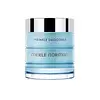What's inside
What's inside
 Key Ingredients
Key Ingredients

 Benefits
Benefits

 Concerns
Concerns

 Ingredients Side-by-side
Ingredients Side-by-side

Water
Skin ConditioningGlycerin
HumectantCetearyl Alcohol
EmollientCaprylic/Capric Triglyceride
MaskingCetyl Alcohol
EmollientCeteareth-20
CleansingPetrolatum
EmollientPotassium Phosphate
BufferingCeramide NP
Skin ConditioningCeramide AP
Skin ConditioningCeramide EOP
Skin ConditioningCarbomer
Emulsion StabilisingDimethicone
EmollientBehentrimonium Methosulfate
Sodium Lauroyl Lactylate
EmulsifyingSodium Hyaluronate
HumectantCholesterol
EmollientPhenoxyethanol
PreservativeDisodium EDTA
Dipotassium Phosphate
BufferingTocopherol
AntioxidantPhytosphingosine
Skin ConditioningXanthan Gum
EmulsifyingEthylhexylglycerin
Skin ConditioningWater, Glycerin, Cetearyl Alcohol, Caprylic/Capric Triglyceride, Cetyl Alcohol, Ceteareth-20, Petrolatum, Potassium Phosphate, Ceramide NP, Ceramide AP, Ceramide EOP, Carbomer, Dimethicone, Behentrimonium Methosulfate, Sodium Lauroyl Lactylate, Sodium Hyaluronate, Cholesterol, Phenoxyethanol, Disodium EDTA, Dipotassium Phosphate, Tocopherol, Phytosphingosine, Xanthan Gum, Ethylhexylglycerin
Water
Skin ConditioningCyclopentasiloxane
EmollientIsodecyl Neopentanoate
EmollientHydrogenated Polyisobutene
EmollientGlycerin
HumectantButylene Glycol
HumectantIsohexadecane
EmollientStearic Acid
CleansingCetyl Alcohol
EmollientNylon-12
Glyceryl Stearate
EmollientStearyl Alcohol
EmollientDimethicone
EmollientGlyceryl Polymethacrylate
Acetyl Hexapeptide-8
HumectantPalmitoyl Tripeptide-1
Skin ConditioningSerine
MaskingGlycine
BufferingProline
Skin ConditioningPalmitoyl Carnitine
Skin ConditioningAlanine
MaskingGlutamic Acid
HumectantCamellia Sinensis Leaf Extract
AntimicrobialCalluna Vulgaris Flower Extract
Skin ConditioningCentella Asiatica Extract
CleansingRetinyl Palmitate
Skin ConditioningTocopheryl Acetate
AntioxidantAscorbyl Palmitate
AntioxidantPCA
HumectantPhospholipids
Skin ConditioningChamomilla Recutita Flower Extract
MaskingEchinacea Purpurea Extract
MoisturisingPEG-20 Stearate
EmulsifyingPEG-100 Stearate
Dimethicone Crosspolymer
Emulsion StabilisingBisabolol
MaskingAcrylates/C10-30 Alkyl Acrylate Crosspolymer
Emulsion StabilisingXanthan Gum
EmulsifyingEthoxydiglycol
HumectantLecithin
EmollientGlucose
HumectantLactic Acid
BufferingTriethanolamine
BufferingPropylene Glycol
HumectantDisodium EDTA
Phenoxyethanol
PreservativeDiazolidinyl Urea
PreservativeWater, Cyclopentasiloxane, Isodecyl Neopentanoate, Hydrogenated Polyisobutene, Glycerin, Butylene Glycol, Isohexadecane, Stearic Acid, Cetyl Alcohol, Nylon-12, Glyceryl Stearate, Stearyl Alcohol, Dimethicone, Glyceryl Polymethacrylate, Acetyl Hexapeptide-8, Palmitoyl Tripeptide-1, Serine, Glycine, Proline, Palmitoyl Carnitine, Alanine, Glutamic Acid, Camellia Sinensis Leaf Extract, Calluna Vulgaris Flower Extract, Centella Asiatica Extract, Retinyl Palmitate, Tocopheryl Acetate, Ascorbyl Palmitate, PCA, Phospholipids, Chamomilla Recutita Flower Extract, Echinacea Purpurea Extract, PEG-20 Stearate, PEG-100 Stearate, Dimethicone Crosspolymer, Bisabolol, Acrylates/C10-30 Alkyl Acrylate Crosspolymer, Xanthan Gum, Ethoxydiglycol, Lecithin, Glucose, Lactic Acid, Triethanolamine, Propylene Glycol, Disodium EDTA, Phenoxyethanol, Diazolidinyl Urea
 Reviews
Reviews

Ingredients Explained
These ingredients are found in both products.
Ingredients higher up in an ingredient list are typically present in a larger amount.
Cetyl Alcohol is a fatty alcohol. Fatty Alcohols are most often used as an emollient or to thicken a product.
Its main roles are:
Though it has "alcohol" in the name, it is not related to denatured alcohol or ethyl alcohol.
The FDA allows products labeled "alcohol-free" to have fatty alcohols.
Learn more about Cetyl AlcoholDimethicone is a type of synthetic silicone created from natural materials such as quartz.
What it does:
Dimethicone comes in different viscosities:
Depending on the viscosity, dimethicone has different properties.
Ingredients lists don't always show which type is used, so we recommend reaching out to the brand if you have questions about the viscosity.
This ingredient is unlikely to cause irritation because it does not get absorbed into skin. However, people with silicone allergies should be careful about using this ingredient.
Note: Dimethicone may contribute to pilling. This is because it is not oil or water soluble, so pilling may occur when layered with products. When mixed with heavy oils in a formula, the outcome is also quite greasy.
Learn more about DimethiconeDisodium EDTA plays a role in making products more stable by aiding other preservatives.
It is a chelating agent, meaning it neutralizes metal ions that may be found in a product.
Disodium EDTA is a salt of edetic acid and is found to be safe in cosmetic ingredients.
Learn more about Disodium EDTAGlycerin is already naturally found in your skin. It helps moisturize and protect your skin.
A study from 2016 found glycerin to be more effective as a humectant than AHAs and hyaluronic acid.
As a humectant, it helps the skin stay hydrated by pulling moisture to your skin. The low molecular weight of glycerin allows it to pull moisture into the deeper layers of your skin.
Hydrated skin improves your skin barrier; Your skin barrier helps protect against irritants and bacteria.
Glycerin has also been found to have antimicrobial and antiviral properties. Due to these properties, glycerin is often used in wound and burn treatments.
In cosmetics, glycerin is usually derived from plants such as soybean or palm. However, it can also be sourced from animals, such as tallow or animal fat.
This ingredient is organic, colorless, odorless, and non-toxic.
Glycerin is the name for this ingredient in American English. British English uses Glycerol/Glycerine.
Learn more about GlycerinPhenoxyethanol is a preservative that has germicide, antimicrobial, and aromatic properties. Studies show that phenoxyethanol can prevent microbial growth. By itself, it has a scent that is similar to that of a rose.
It's often used in formulations along with Caprylyl Glycol to preserve the shelf life of products.
Water. It's the most common cosmetic ingredient of all. You'll usually see it at the top of ingredient lists, meaning that it makes up the largest part of the product.
So why is it so popular? Water most often acts as a solvent - this means that it helps dissolve other ingredients into the formulation.
You'll also recognize water as that liquid we all need to stay alive. If you see this, drink a glass of water. Stay hydrated!
Learn more about WaterXanthan gum is used as a stabilizer and thickener within cosmetic products. It helps give products a sticky, thick feeling - preventing them from being too runny.
On the technical side of things, xanthan gum is a polysaccharide - a combination consisting of multiple sugar molecules bonded together.
Xanthan gum is a pretty common and great ingredient. It is a natural, non-toxic, non-irritating ingredient that is also commonly used in food products.
Learn more about Xanthan Gum